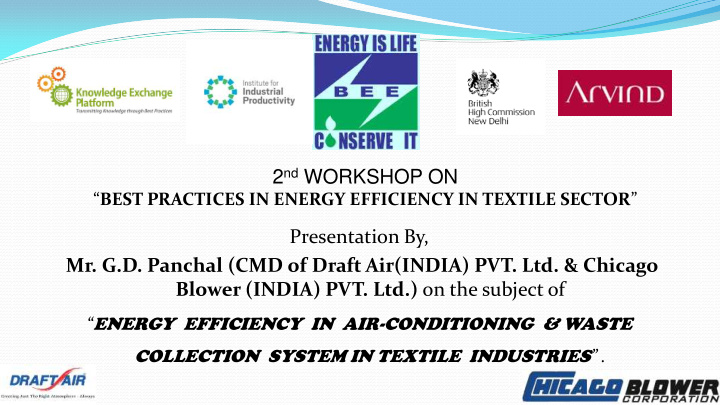



2 nd WORKSHOP ON “ BEST PRACTICES IN ENERGY EFFICIENCY IN TEXTILE SECTOR ” Presentation By, Mr. G.D. Panchal (CMD of Draft Air(INDIA) PVT. Ltd. & Chicago Blower (INDIA) PVT. Ltd.) on the subject of “ ENERGY EFFICIENCY IN AIR-CONDITIONING & WASTE COLLECTION SYSTEM IN TEXTILE INDUSTRIES ” .
Energy Saving Up to 25% in Textile Air Conditioning Economical System Design Selection of Economical Equipments to match the requirement of Efficient System Design Effective Distribution of Supply and Return Air with Appropriate balancing E-Communication with the Variable Frequency Drive.
Efficient System Design Location Of Plant 1) Damper Location 2) Fresh Air-Damper A. Exhaust Air-Damper B. Return Air Damper C. Location of Fan & Fan Accessories 3) “Bell Shaped” Inlet Cones A. Outlet Cone at Fan Discharge side. B. Extra Precautions should be considered such as Distance C. between inlet/outlet of FAN and the Wall
Fan Performance Respective to the Wall Distance
Economical Selection of Equipments Supply Air Fans Pumps And Piping 1) 4) 2 Bank System Return Air Fans 2) a) 2 Pump Each of 50 % Capacity b) Rotary Air Filters 3) Saving in 5 % to 10 % in c) energy cost Saving is possible with both d) Manual and Automatic Operation of the Pumps.
Effective Distribution of Supply and Return Air with Appropriate balancing Distribution of Air According to Heat Concentration. Apposite Design of SA Duct and Return Air trenches. Flow of Air - Laminar Velocity of Air- Uniform & Constant Direction of Air- From Diffuser to Grilles Uniform Velocity Through Diffuser & Uniform Suction through Grilles.
Suitable Provision for Distribution of Air helps in Efficient balancing of Supply Air and Return Air in the Department. Consistent and Uniform Air Quantity. No Hot Pockets in the Department. Enhancement in Quality of YARN and FABRIC. Removal of Floating Fluff in Department.
CAUTION Apart from properly Designed Supply Air Duct enough attention should be given to Return Air Trench. Normally Velocity through grilles near the return air system is more than the designed velocity compared to the grilles which are located away. This variation in velocity vary according to department length, number of ducts and size of the grilles . Variation in velocity causes hot pockets , floating fluff, turbulence of air and severe imbalance of system
Enough Attention Shall be given to Overcome such Problem by, Replacement of Motor with Higher HP Motor. Changing Blade Angles to enhance the capacity. This results ultimately in more POWER CONSUMPTION.
Supply Air & Return Air System normally installed for Simplex
Perfectly Balanced Supply & Return Air System for Simplex
Unbalanced Air Distribution
Resultant of Unbalanced Air Distribution
Proper Balanced System
E-Communication with the Variable Frequency Drive. Automation helps in maintaining the Humidity and Temperature at Constant Level. Proper Mixture of Supply Air and Return Air Set points can be easily changed as per Requirement of Different Department. Control of Speed of the fans through VFDs. Control of flow of water in the spray. CMS(Central Monitoring System) provides Current Data of Different Departments and also has Facility to change the Conditions. System can be also monitored and controlled from Long Distance with help of Net Connectivity.
Need for Variable Frequency Drives Normally Plants are designed for Peak Summer Conditions 1. Maximum Load Factor of Machines 2. But there are situations when:- Atmospheric conditions vary day 1. and night & season to season Machines are working at varying 2. load factor. Thus requirement of air circulation reduces, And here we need VFD on fans.
Effect of Varied FAN-Speed in System If Speed reduces by 10 % FAN LAWS SAYS:- Then , Air Volume reduces by 10 % Air Volume a Speed Pressure reduces by 19 % Power reduces by 27 % Pressure a ( Speed) 2 If Speed increases by 10 % Then , Power a ( Speed) 3 Air Volume increases by 10 % Pressure increases by 21 % Power increases by 33 %
Advantages of Automation and VFDs Savings of power 5-10% when only Automation is installed with 2 Pumps System. 25-30% Minimum power savings if Variable Frequency Drives (VFDs) are also installed with Automation. Recovery of Cost of VFD is very Reliable ,it can be achieved within 15 – 24 months depending upon geographical location of the site, varying load conditions and Power Cost.
FAN DESIGNED AT 2250 PA SCHEMATIC DIA. OF GENERAL TEXTILE WASTE COLLECTION SYSTEM
CLEAN CONDITION CHOCK CONDITION (MINIMUM) (MAXIMUM) -600Pa -800Pa Negative Pressure required by M/C Supplier (-600Pa Minimum M/C operating Cond.) -600Pa -600Pa Duct Loss -50Pa -150Pa Primary (Disc) Filter losses -75Pa -250Pa Secondary(Rotary) Filter Losses -300Pa -300Pa Exhaust Losses -1625Pa -2100Pa TOTAL - 2250 (Considered for final design including unforeseen losses; Air & Duct losses)
PERFORMANCE OF FAN
PERFORMANCE OF SOLO FAN UNDER DIFFERENT DESIGN LOAD
MAINTENANCE OF PLANT This is the Most Important Aspect results, in saving lots of Power. Scheduled Cleaning of Eliminators, Intake Louvers and Nozzles prevents them from chocking. Changing the Past life-timed Parts ensures the stability of plant and Increase the Life-Time of Plant. This will ensure Designed Air Circulation in Department and desired RH & Temperature is continuously maintained.
CREATING JUST THE RIGHT ATMOSPHERE - ALWAYS
Recommend
More recommend